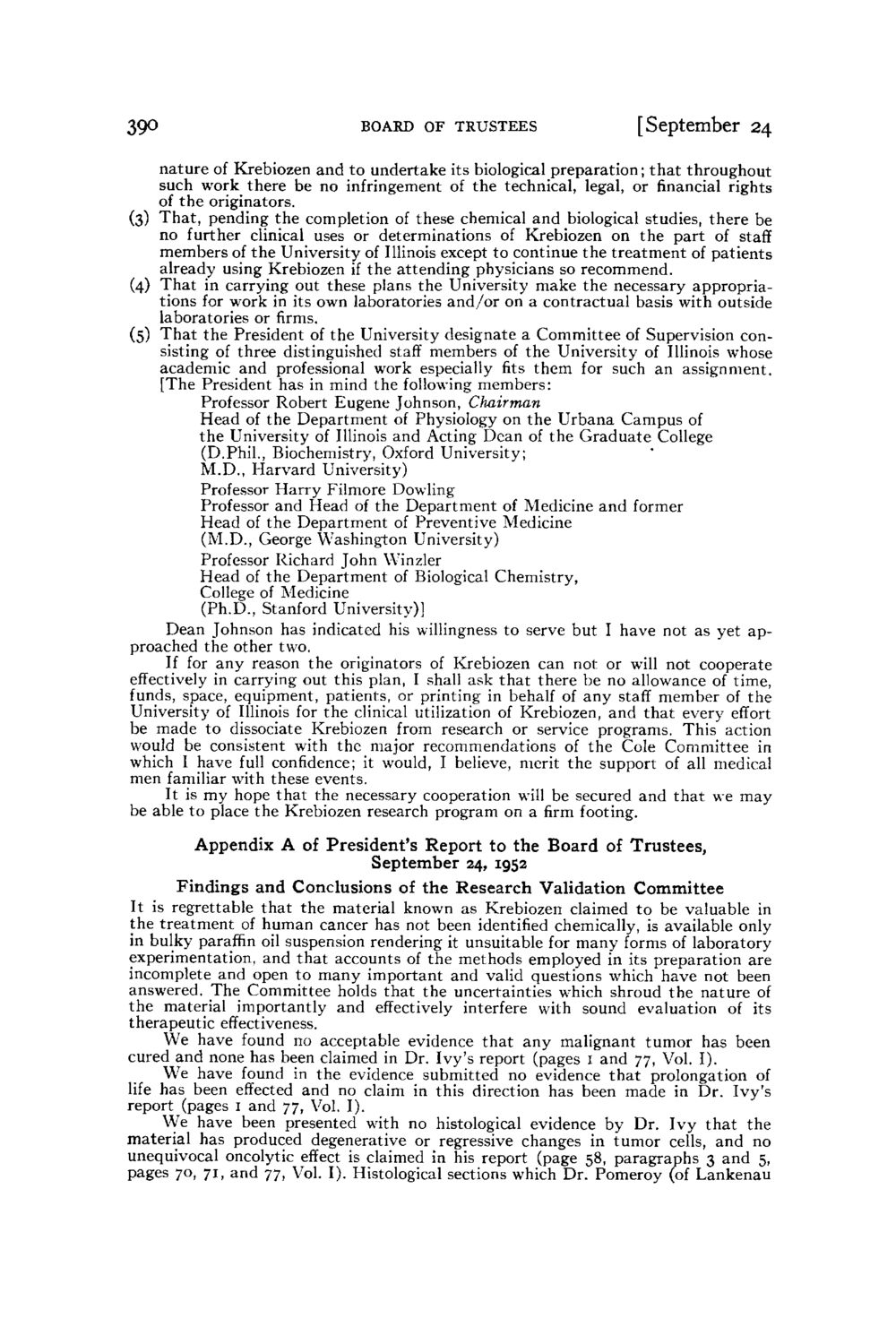| |
| |
Caption: Board of Trustees Minutes - 1954
This is a reduced-resolution page image for fast online browsing.

EXTRACTED TEXT FROM PAGE:
390 BOARD OF TRUSTEES [September 24 nature of Krebiozen and to undertake its biological preparation; that throughout such work there be no infringement of the technical, legal, or financial rights of the originators. (3) That, pending the completion of these chemical and biological studies, there be no further clinical uses or determinations of Krebiozen on the part of staff members of the University of Illinois except to continue the treatment of patients already using Krebiozen if the attending physicians so recommend. (4) That in carrying out these plans the University make the necessary appropriations for work in its own laboratories and/or on a contractual basis with outside laboratories or firms. (5) That the President of the University designate a Committee of Supervision consisting of three distinguished staff members of the University of Illinois whose academic and professional work especially fits them for such an assignment. [The President has in mind the following members: Professor Robert Eugene Johnson, Chairman Head of the Department of Physiology on the Urbana Campus of the University of Illinois and Acting Dean of the Graduate College (D.Phil., Biochemistry, Oxford University; M.D., Harvard University) Professor Harry Filmore Dowling Professor and Head of the Department of Medicine and former Head of the Department of Preventive Medicine (M.D., George Washington University) Professor Richard John Winzler Head of the Department of Biological Chemistry, College of Medicine (Ph.D., Stanford University)] Dean Johnson has indicated his willingness to serve but I have not as yet approached the other two. If for any reason the originators of Krebiozen can not or will not cooperate effectively in carrying out this plan, I shall ask that there be no allowance of time, funds, space, equipment, patients, or printing in behalf of any staff member of the University of Illinois for the clinical utilization of Krebiozen, and that every effort be made to dissociate Krebiozen from research or service programs. This action would be consistent with the major recommendations of the Cole Committee in which I have full confidence; it would, I believe, merit the support of all medical men familiar with these events. It is my hope that the necessary cooperation will be secured and that we may be able to place the Krebiozen research program on a firm footing. Appendix A of President's Report to the Board of Trustees, September 24, 1952 Findings and Conclusions of the Research Validation Committee It is regrettable that the material known as Krebiozen claimed to be valuable in the treatment of human cancer has not been identified chemically, is available only in bulky paraffin oil suspension rendering it unsuitable for many forms of laboratory experimentation, and that accounts of the methods employed in its preparation are incomplete and open to many important and valid questions which have not been answered. The Committee holds that the uncertainties which shroud the nature of the material importantly and effectively interfere with sound evaluation of its therapeutic effectiveness. We have found no acceptable evidence that any malignant tumor has been cured and none has been claimed in Dr. Ivy's report (pages I and 77, Vol. I). We have found in the evidence submitted no evidence that prolongation of life has been effected and no claim in this direction has been made in Dr. Ivy's report (pages I and 77, Vol. I). We have been presented with no histological evidence by Dr. Ivy that the material has produced degenerative or regressive changes in tumor cells, and no unequivocal oncolytic effect is claimed in his report (page 58, paragraphs 3 and 5, pages 70, 71, and 77, Vol. I). Histological sections which Dr. Pomeroy (of Lankenau
| |